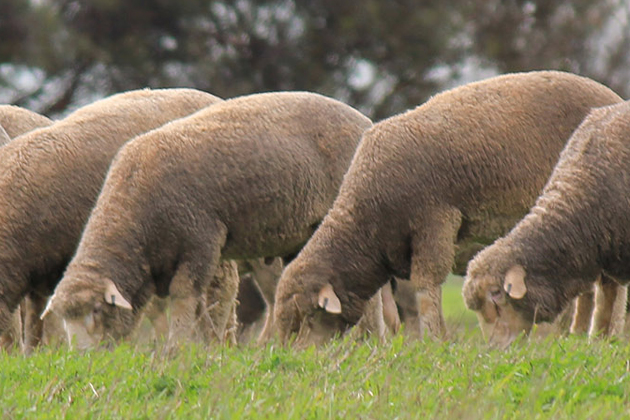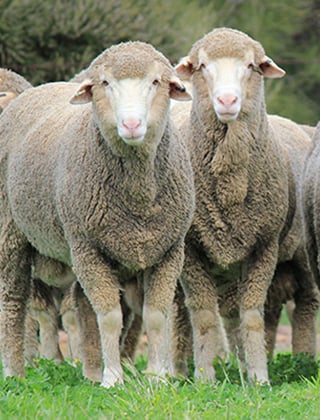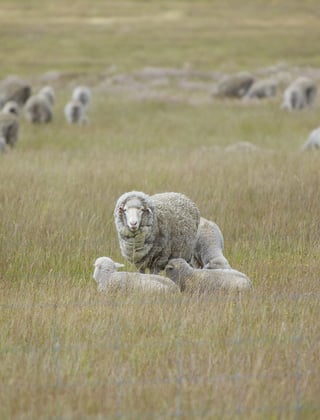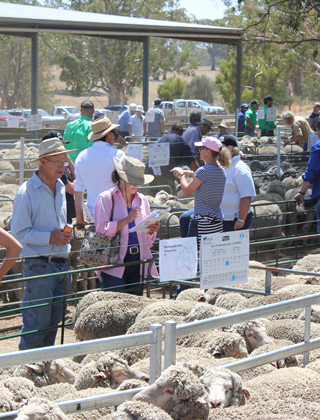Assessing, classing and selecting sheep

Assessing and selecting sheep to achieve optimal genetic gain involves a wide range of issues. This article works through the issues and breaks down some of the component topics that are often discussed.
Achieving optimal genetic gain involves issues ranging from understanding the impact the environment has on how sheep look and perform (phenotype), the need to reduce the impact of non-genetic variables so the phenotypic differences are due as much as possible to genetic differences (genotype), to having a breeding objective that is focused on what the market will be seeking in the next 10 years for a specific environment.
Some of the component topics regarding assessing, classing, and selecting sheep are outlined below.
Environment
- The environment plays an important role in setting the right breeding objective and sheep type.
- It is important for woolgrowers to understand how local conditions impact on their sheep and which sheep are best suited to it.
- Taking sheep from one environment to another may change how traits are expressed, ie fleece cut, micron, fleece rot, wrinkle, and worm resistance. Sheep bred for one environment may perform differently if moved to a different region, ie to high rainfall regions, high worm areas, or into wheat sheep and or pastoral regions.
- Growers may be better off buying rams that have been bred locally or are from a similar environment.
- What is fit for purpose in one environment or production system may not be fit for purpose for another.
Assessment protocols
- 44% of commercial woolgrowers class their own sheep and 25% of woolgrowers breed their own rams. A good understanding of the protocols and when to class sheep is important to optimising lifetime wool and lamb productivity.
- It is important to follow the protocols for good assessments; they are the same for both visual and objective assessments.
- Good protocols include tight lambing, identifying multiples and maiden progeny, maintaining as few management groups as possible for a drop/mob, the right timing when to take each assessment, a good husbandry and animal health program, and maintaining best practice commercial condition scores.
- Evaluate within management groups as old as is appropriate.
- The older you class your sheep, the lower the impacts of confusing early life non-genetic effects.
- Rising 1-year-old assessments can be good for sire progeny testing, but when selecting individuals, rising 2-year-old assessments are better predictions of an individual’s lifetime fleece productivity. Be cautious of post weaner or yearling fleece weights; think hogget or adult ages.
- Commercial reality often leads ram breeders to compromise on the protocols, so it is important to make informed decisions and be aware of the consequences.
- Breeders with good assessment protocols have breeding values that change less than breeders with poor assessment protocols. Over time, ram buyers work it out, it’s buyer beware.
Assessments
- Visual assessments or raw data is the assessment of how an individual sheep looks and performs.
- Breeding values are an assessment of how that animal’s progeny will look and perform.
- There should be a strong alignment between good visual and objective assessments when the protocols are followed. If not, something is amiss.
- The assessment method, be it visual, raw data or breeding value does not improve the quality of the animal, objective assessments are only a benchmark.
- Just because an animal has or does not have data does not make it a better animal. Data reduces risk at a cost.
- There are good sheep with figures and good sheep without figures. There are poor sheep with figures and there are poor sheep without figures.
- Visual assessments and classing require constant review, attention to the protocols, concentration, rechecking classing splits and staying consistent throughout the day.
- Objective assessments require constant review, attention to protocols’ taring scales, choice of pregnancy scanner, choice of wool lab or WEC lab or consultants.
- Breeding values evolve with more data, that is how they work, changes are expected. The more data the more confidence that the estimated breeding value prediction is approaching the ‘true’ breeding value.
Classing
- Only 31% of woolgrowers use an external sheep classer.
- In MLP project analysis to date, there is a positive correlation between good structure and productivity.
- In some areas there are much higher restocker prices for sheep with good structure and frame.
- MLP project results show classers’ overall grading is correlated with productivity which backs up results from the SARDI Selection Flock and QPlu$ trial conducted in the 1990s.
- As 25% of woolgrowers don’t class, a key message from the MLP project is to consider the merits of getting a sheep classer.
- Classers won’t be replaced by data, people make good breeding decisions and sell rams, figures assist.
- Culling a moderate number of absolute culls before the main classing has little impact as they tend to be random across the other key economic traits.
- At the main classing, some woolgrowers believe in the need to get conformation and quality right first then productivity; others believe the need is to be productive first. Although the general view is that all traits need to be assessed together, one should not be ahead of the other.
- There is no perfect sheep, and every classing decision is a compromise based on the owner’s or classer’s overall objectives for the flock.
Benchmarking
- 25% of woolgrowers breed their own rams and there are a range of new ways to benchmark progress without collecting breeding values on a commercial progeny. They can include the DNA flock Profile and averaging the ASBVs of AI or purchased stud sires.
- Sheep with good figures doesn’t mean they are good sheep, but sheep with poor figures are poor sheep.
- Sheep with good structure doesn’t mean they are good sheep, but sheep with poor structure are poor sheep.
Breeding objectives
- Breeding objectives direct sheep selection decisions.
- A breeding objective defines what is predicted to be the most profitable future enterprise for a specific business and environment at an acceptable level of risk.
Indexes
- Indexes are a guide only and care is needed to get the production system and index assumptions right.
- Rarely do indexes include all the important traits.
- High indexing sheep can often have individual traits you want to cull.
- Indexes with highly heritable, highly visual traits should align well with visual assessments, however indexes with key traits that are lowly heritable and difficult to visually assess will not align as well. (These indexes are likely to include non-visual traits such as staple strength, worm resistance, weaning rate, genomics and soon to be footrot and methane.)
- If a trait is important enough to be in your index it is worth taking a direct assessment, rather than relying on indirect measures. Only when a trait is difficult or expensive to measure should correlations be the focus.
- There are woolgrowers that overly rely on objective assessments and indexes and others that don’t rely on them enough.
- If there are too many high indexing ‘culls’ then the production system and index is not suited to your business. If the standard indexes don’t match your enterprise or what is important in the next decade, check out custom indexes.
When the limitations of, visual assessments, raw data, objective assessments, breeding values and indexes are well understood, the fastest change can be made. The best long term breeding objective is then vital so that change is going in the right direction.
More information: Geoff Lindon, AWI Program Manager, Sheep Genetics & Animal Welfare Advocacy, Geoff.Lindon@wool.com
This article appeared in the December 2023 edition of AWI’s Beyond the Bale magazine. Reproduction of the article is encouraged.















